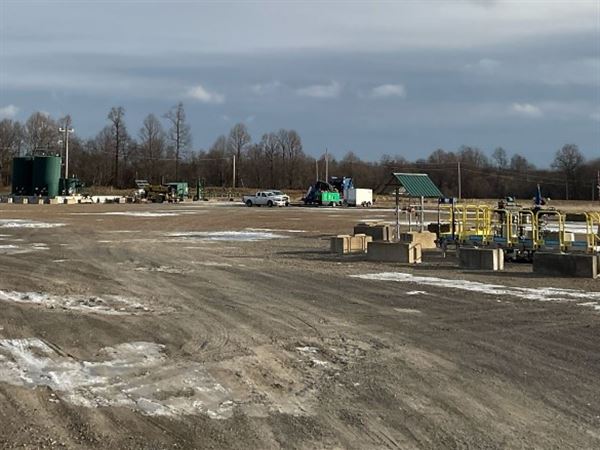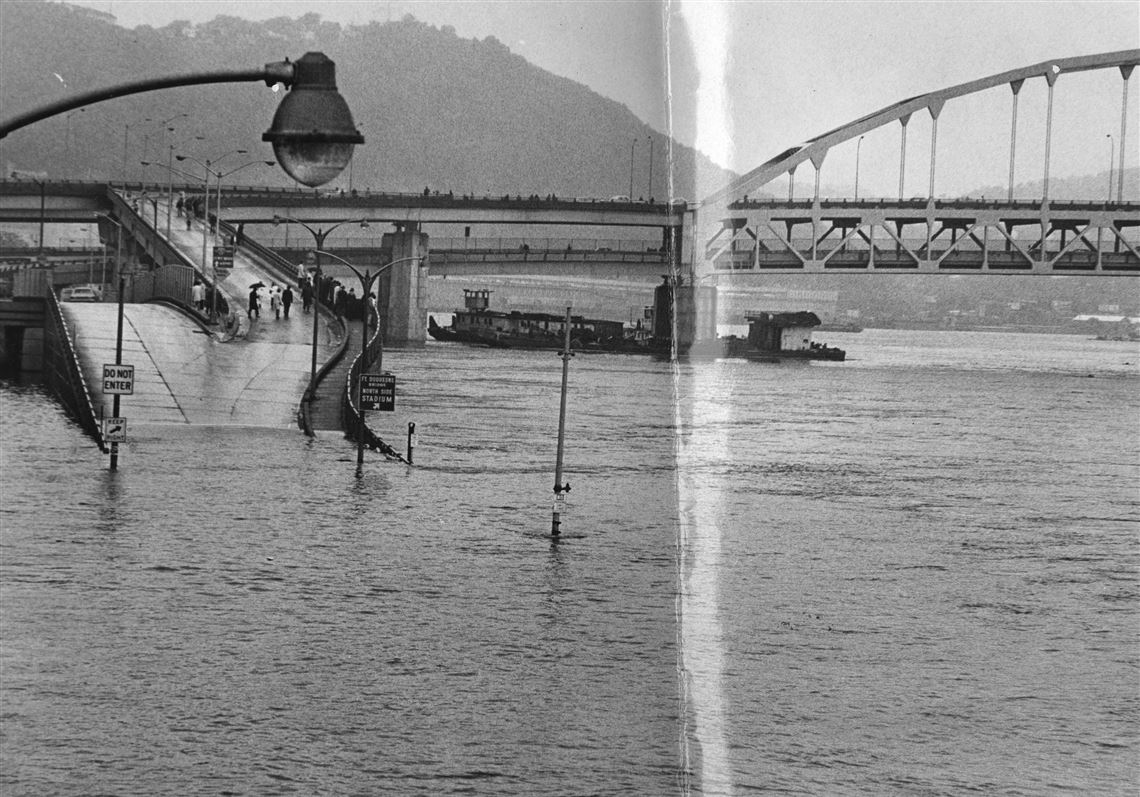Fifty years ago, Downtown Pittsburgh was briefly a “ghost town,” Glen Engle recalls.
While meandering through the city streets after an unsurprisingly quiet lunch shift in late June 1972, a curious Mr. Engle, then 16, reached what is now Point State Park. He waded into chest-deep waters, soaking in the view of the Ohio River before him.
It was a deluge of Hurricane Agnes’ creation.
Upon making landfall as a Category 1 hurricane over the Florida Panhandle on June 19, Agnes lost its strength. It was downgraded to a tropical storm; the next day, it was downgraded further to a tropical depression.
But it soon regained power and re-reached tropical storm strength, traveling over the Atlantic, making a second landfall June 22 near New York City and eventually combining with another storm system on June 23.
At that point, Agnes stalled over the Northeast — and slammed Pennsylvania and New York with torrential rain.
“By the time Agnes actually got here, the town was paralyzed,” Mr. Engle said.
Rainfall in Pittsburgh reached 11 inches, as Agnes punished the region with endless showers for several days, while Pennsylvania’s hardest-hit spots received up to 19 inches.
At the time, Agnes was the most expensive hurricane in U.S. history, totaling upward of $3 billion in damage, of which more than $2 billion befell Pennsylvania alone. Nationwide, Agnes left 128 people dead, including 50 in Pennsylvania, according to the National Weather Service.
It’s been half a century since Agnes delivered its devastating downpours. But decades later, the hurricane’s legacy lives on for those who witnessed it and those who study storms of similar proportions.
In Pittsburgh, where there were no fatalities, some residents who experienced Agnes remember witnessing some bewildering sights: engulfed neighborhoods, boat rides through Downtown and, occasionally, a few stray fish.
Memoirs of a swamped summer
When Agnes interrupted life in Western Pennsylvania, Darby Trovato was celebrating her graduation from Quaker Valley High School. It was “surreal,” she said, seeing residents rowing boats to navigate the flooded town, including the high school’s field and the local shopping center.
“Being kids in Pennsylvania, we didn’t know what a hurricane really was,” said Ms. Trovato, now 68. “It just wasn’t in our wheelhouse.”
Jean Kestner, a close friend of Ms. Trovato’s since childhood, also remembers seeing boaters on the high school’s campus. But she said her most vivid memory from June 1972 was her time as a counselor at a weeklong camp for elementary school students taught by biology teacher Edward Schroth.
For Mr. Schroth, who was passionate about environmental education “long before it became popular,” Agnes — which flooded one park where camp activities were planned — provided an instructional opportunity.
“We could have stuck to the lesson plan, but Mr. Schroth was a carpe diem kind of guy,” Ms. Kestner, 68, wrote in an email. “We took the kids to the park, had them find the high water marks in the trees, then taught them to calculate the volume of water that filled the park.”
“I still think about that unique lesson and wonder if the students realized they were experiencing a once-in-a-lifetime opportunity,” she added.
John Rompala’s parents had moved their family into a new home on a hillside in Bethel Park three months before Agnes. During the storm, a nearby creek overflowed and filled the lower end of their backyard with roughly 3 feet of water.
So, 13-year-old John, his brother and some friends borrowed a neighbor’s canoe for an unusual ride.
“We said, ‘Hey, let’s just put this thing in,’” said Mr. Rompala, 63, of Penn Hills. “We weren’t in any danger because there was no swift water.”
Margaret Grejda Smith said Agnes brought more than a foot of water into her parents’ weekend cottage in Fombell.
Her father, when speaking of the flooding, often reminisced about the fish “flipping around in the grass.”
“You literally had to go from the main road with a rowboat to get to the house,” said Ms. Smith, 69, of Shaler. “You just basically had to wait for Mother Nature to have everything recede.”
A greater crisis averted
After Agnes finally dissipated and the full extent of the damage it wrought came into focus, it became clear that Pittsburgh weathered the storm’s wrath relatively well.
Following the Great St. Patrick’s Day Flood of 1936 — which destroyed Downtown businesses and washed out other towns around the region — the Flood Control Act of 1936 paved the way for the U.S. Army Corps of Engineers Pittsburgh District to build a system of 16 dams and reservoirs to reduce future flood damages.
Without those projects, Agnes would have inundated Pittsburgh with far more ruinous flood levels than it ultimately experienced, said Werner Loehlein, who retired from Pittsburgh’s Corps of Engineers in 2016 as its chief of water management after a 44-year career there.
“Even though there was [a] significant amount of damage, it would have been a lot worse,” Mr. Loehlein said.
Hours after a flash flood warning was issued in Pittsburgh on June 23, Agnes caused river waters to rise past the 25-foot flood stage. Flooding peaked at 35.8 feet in Downtown during the early morning of June 24.
A post-flood report produced by Pittsburgh’s Corps of Engineers in October 1974 found that Agnes’ flood levels would have surpassed the height of the record-holding 1936 flood by 2 feet, cresting at 47.9 feet, had it not been for the reservoir system in place.
The report said Pittsburgh saw almost $91 million in flood damage but estimated that existing flood-control measures prevented about $850 million in additional costs.
“That the destruction did not occur, that no lives were lost due to the flood in the Pittsburgh District, was described in the news media as a ‘minor miracle,’” the report read. “But it was not minor, nor was it a miracle in the ordinary sense of the [word]; it was principally the result of more than a third of a century of hard work by the Pittsburgh Engineer District.”
Anne Madarasz, chief historian at the Heinz History Center, said Agnes was particularly calamitous overall because of its massive size as well as the protracted path it charted.
“It was the volume of tropical water that it picked up, and it was the fact that it was such a big storm — it covered over 1,000 miles — and it sort of stalled,” she said. “It really dumped a lot of water over the course of several days.”
While Pittsburgh endured serious losses, Ms. Madarasz, like Mr. Loehlein, attributes the city’s ability to ward off the kind of economic and human toll seen in Central Pennsylvania to its flood preparedness.
But when the next Agnes-level tempest descends on the state, will Pittsburgh be ready for impact?
In the last 50 years, technological advancements — including in weather satellites, radars and computer modeling — have dramatically improved how experts forecast storms.
“Our ability to detect and analyze these storms has increased tremendously,” said Jack Beven, a senior hurricane specialist at the National Hurricane Center. “In 1972, our ability to forecast how much rain would fall from an event like Agnes was much less than it would be today.”
Even so, when another flood disaster might strike is hardly predictable.
“In theory, we could see an event like Agnes again at some point in the future when the right series of ingredients comes together,” Mr. Beven said. “I just can’t tell you when and exactly where.”
For now, Mr. Loehlein is optimistic that if and when the time comes, the city’s emergency responders will be equipped to step in.
“As long as they keep doing what they’re doing, then when we do have something that starts to approach Hurricane Agnes,” he said, “they will be able to effectively respond to provide whatever’s needed.”
Alex Koller: akoller@post-gazette.com.
First Published: June 27, 2022, 10:00 a.m.
Updated: June 28, 2022, 11:02 a.m.






















